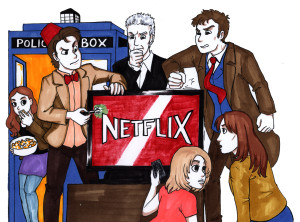Is The Rising Popularity of Individual Streaming Sites a Blessing or a Curse?
American fans of the popular British sci-fi series “Doctor Who” were left in the dark when streaming sites Netflix and Hulu announced that the series would no longer be a part of their subscription services as of February 1. Although the series is still available through BBC America, those interested in “binge watching” it will have to purchase 12 seasons on DVD, with each season priced at approximately $74.98 on the official BBC Doctor Who shop – a cost significantly higher than Netflix’s basic monthly subscription fee of $7.99.
However, “Doctor Who” is not the first program to be pulled from Netflix. Television shows have come and gone since the company launched as a streaming service in 2007; the list of popular shows pulled from streaming over the last four years alone include “Mythbusters”, “Spongebob Squarepants”, “South Park”, “Teen Wolf”, “Keeping Up with the Kardashians”, “Veronica Mars”, and “Desperate Housewives”, as well as countless others.
What separates “Doctor Who” from this list is its reason for being pulled.

In 2015, director general of BBC, Tony Hall, announced that the network would be launching its own streaming service in 2016. At a press conference attended by the Hollywood Reporter, Hall stated, “Next year, we’re launching a new OTT [“over-the-top” content; delivery of media over the Internet without the involvement of a multiple-system operator as opposed to the purchase or rental of digital content via an Internet service provider] video service in America offering BBC fans programs they wouldn’t otherwise get.”
At first, this development might seem like the American “Doctor Who” fan’s dream come true. It does, however, raise the possibility of a larger problem.
The rising popularity of streaming sites came about shortly after the rising popularity of the Internet and illegal downloading. When viewers realized they could watch their favorite shows for free on their computers at their leisure, as long as they were willing to take the risk of downloading them illegally, they jumped at the chance.
Enter Netflix, which began as a DVD-by-mail service in 1998. After delivering their 1 billionth DVD in February 2007, the site began offering video streaming to its customers via the Internet.
Since then, Netflix has grown staggeringly quickly into one of the largest content libraries legally available, with close to 7,000 titles at any given time. Gone were the drawbacks of hour-long buffering, risk of viruses, and the infamous pop-up advertisements. No more scouring the Internet to find a link to the next episode of your favorite show and hoping beyond hope it wouldn’t crash your entire laptop.
Now you could watch three episodes on Netflix in the time it took one illegal download to buffer. For a price almost too good to be true, audiences were granted full control to watch what they wanted, when they wanted, for however long they wanted.
Soon after Netflix came Hulu and Amazon Prime. These three main streaming services give audiences a choice as to which provider they prefer, but are essentially the same type of service. They all offer movies and television shows from various networks and production studios.
This brings us back to Netflix and Hulu dropping “Doctor Who”.
BBC is not the first to decide to release its own streaming service. Other TV streaming services include HBO Now, CBS All Access, Warner Archive Instant, and PBS Video, the only one listed that does not charge for its subscription.
It is clear why networks feel pressured into cashing in on the growing popularity of streaming sites. Theoretically, it’s the perfect solution for reaching out to younger, more tech-savvy fans. The idea behind it is simple; audiences are watching the networks’ shows on a third party site. Remove the third party, add your own spin on the same service, and audiences will spend money on yours instead.
While the logic is understandable, it is also incredibly unrealistic. No one wants to go back to the dark ages of buffering, pop-ups, and viruses, but they also don’t want to be forced to pay separate subscription fees for each network they watch. Especially if, like in my case, there are only one or two shows I actually watch per network.
However much I love Martin Freeman, I’m not going to pay $15.99 a month for HBO Now just so I can watch “Fargo”.
The beauty of a streaming site such as Netflix is that it’s affordable enough that its users – even high school and college students, which made up a hefty 65% of its American usage last year, according to global web index – are willing to pay for the convenience of having programs from multiple networks in one neat little package. Which is very bad news for those networks trying to cash in on individual streaming services.
They are making it less convenient for their audiences, not more. Several sites offer pirated movies and TV shows for free, albeit at higher risk and lower quality, so why bother paying for a more inconvenient process than Netflix currently provides at a cheaper price? And those who are willing to pay the higher cost for multiple streaming sites will find their mobile devices cluttered and their data space wasted.
In short, what BBC and other networks are doing in pulling their shows from Netflix in favor of their own streaming services is taking a massive step backwards. If they are truly interested in keeping their younger, busier, media-hungry audiences, they would be better off renegotiating their contracts with Netflix, Hulu, and Amazon Prime.



